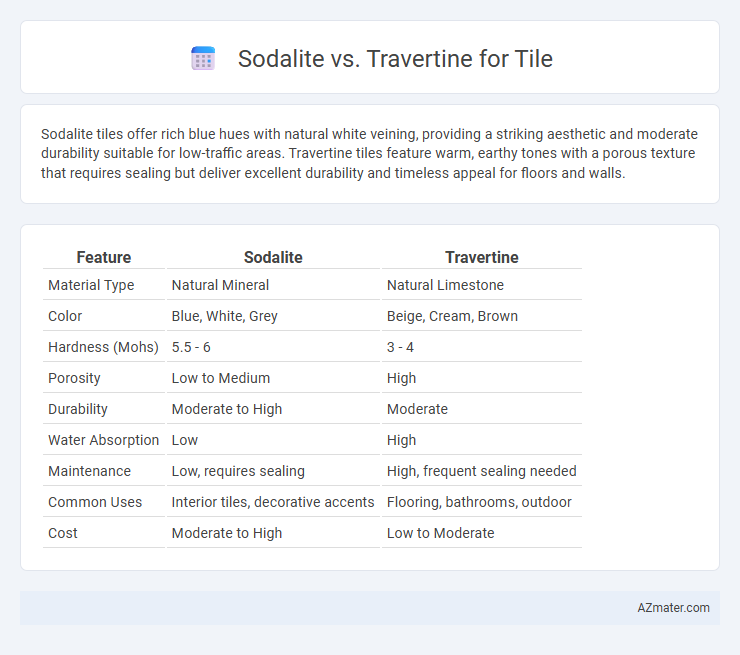Sodalite tiles offer rich blue hues with natural white veining, providing a striking aesthetic and moderate durability suitable for low-traffic areas. Travertine tiles feature warm, earthy tones with a porous texture that requires sealing but deliver excellent durability and timeless appeal for floors and walls.
Table of Comparison
| Feature | Sodalite | Travertine |
|---|---|---|
| Material Type | Natural Mineral | Natural Limestone |
| Color | Blue, White, Grey | Beige, Cream, Brown |
| Hardness (Mohs) | 5.5 - 6 | 3 - 4 |
| Porosity | Low to Medium | High |
| Durability | Moderate to High | Moderate |
| Water Absorption | Low | High |
| Maintenance | Low, requires sealing | High, frequent sealing needed |
| Common Uses | Interior tiles, decorative accents | Flooring, bathrooms, outdoor |
| Cost | Moderate to High | Low to Moderate |
Introduction to Sodalite and Travertine Tiles
Sodalite tiles exhibit striking deep blue hues with white veining, prized for their unique, natural patterns and durability in both indoor and outdoor applications. Travertine tiles, composed of sedimentary limestone, feature warm earth tones and a porous texture that offers a timeless, classic aesthetic ideal for flooring and wall cladding. Both materials provide distinct visual appeal and performance characteristics tailored to various architectural and design needs.
Origins and Geological Formation
Sodalite originates from nepheline syenite and is a rare, deep blue tectosilicate mineral formed in silica-poor igneous rocks, primarily occurring in locations like Canada, Brazil, and Russia. Travertine is a sedimentary carbonate rock formed through rapid precipitation of calcium carbonate from mineral-rich hot springs or limestone caves, commonly found in Italy, Turkey, and Mexico. The contrasting geological formation processes result in sodalite's vibrant blue hues and crystalline texture versus travertine's porous, earthy tones and banded structure.
Appearance and Color Variations
Sodalite tiles exhibit a deep blue hue with white veining, creating a striking and vibrant appearance ideal for bold design statements. Travertine tiles offer a softer, earthy palette featuring beige, cream, and tan tones with natural pitting and texture that provide a rustic, warm ambiance. Color variations in Sodalite are more intense and dramatic, while Travertine presents subtle, neutral shades suitable for classic and timeless interiors.
Durability and Hardness Comparison
Sodalite exhibits a Mohs hardness of approximately 5.5 to 6, making it moderately durable but more prone to scratches and wear compared to travertine, which typically scores around 3 to 4. Travertine's porous composition requires sealing to enhance its durability and resistance to stains, while sodalite's denser crystalline structure offers better natural resistance to abrasion. When selecting tiles for high-traffic areas, sodalite is preferred for its superior hardness, whereas travertine provides a softer, more porous surface that demands regular maintenance.
Maintenance and Cleaning Requirements
Sodalite tiles require minimal maintenance, as their dense composition resists stains and moisture, making them easy to clean with mild soap and water. Travertine tiles, being porous, demand regular sealing to prevent stains and moisture penetration, and require gentle cleaning with pH-neutral cleaners to avoid surface damage. The upkeep intensity for Travertine is higher compared to the low-maintenance nature of Sodalite, influencing tile longevity and appearance retention.
Cost and Value Differences
Sodalite tiles typically cost more than travertine due to their unique blue hues and rarity, making them a premium choice for distinctive interior designs. Travertine offers a more budget-friendly option with a classic, timeless look, often priced lower due to its abundant availability and natural formation process. While sodalite provides high visual impact and exclusivity, travertine delivers excellent value with durability and versatile aesthetics that fit various design styles.
Slip Resistance and Safety
Sodalite tiles offer moderate slip resistance due to their smooth surface and dense composition, making them suitable for indoor areas with light foot traffic but requiring caution when wet. Travertine tiles provide better slip resistance, especially when honed or tumbled, because of their natural textured surface, enhancing safety in areas prone to moisture such as bathrooms and kitchens. Selecting travertine over sodalite can significantly reduce slip hazards, contributing to safer flooring environments.
Installation Process and Techniques
Sodalite tiles require precise cutting and grout lines due to their hardness and unique veining, making it essential to use diamond blades and a wet saw during installation to prevent chipping and ensure clean edges. Travertine tiles demand careful handling because of their porous nature, typically needing sealing before and after installation, and require a thicker layer of thin-set mortar to accommodate their uneven surface and reduce lippage. Both materials benefit from a professional installation approach involving leveling systems and appropriate grout types to maintain durability and aesthetic appeal over time.
Best Uses and Applications
Sodalite tiles offer rich blue hues ideal for decorative backsplashes, accent walls, and luxurious bathroom designs, providing a striking visual impact with moderate durability. Travertine tiles, known for their warm earth tones and natural porous texture, are best suited for flooring, patios, and high-traffic areas where slip resistance and timeless aesthetics are important. Both materials perform well indoors, but Travertine's natural resilience makes it preferable for outdoor applications and spaces requiring more robust wear resistance.
Environmental Impact and Sustainability
Sodalite tiles are valued for their natural origin and durability, offering a low environmental impact due to minimal processing and long lifespan. Travertine, a sedimentary rock extensively quarried, raises sustainability concerns because of energy-intensive extraction and transportation. Choosing sodalite enhances eco-friendly tiling solutions by reducing carbon footprint and conserving natural resources compared to travertine.

Infographic: Sodalite vs Travertine for Tile
 azmater.com
azmater.com